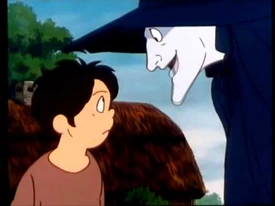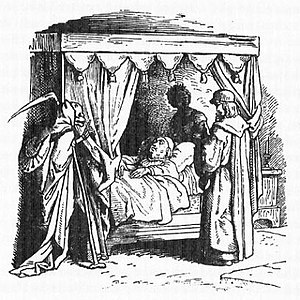
Screenshot from the "Godfather Death" episode of the Japanese anime series Grimm's Fairy Tale Classics.
"Godfather Death" (German: "Der Gevatter Tod") is a German folktale that is included in Kinder- und Hausmärchen (Children's and Household Tales), the 1812 anthology compiled by the Brothers Grimm. Similar stories exist in Irish, Lithuanian, Polish and Mexican folklore.
The plot is set in motion when a poor man looks for a godfather to take care of his thirteenth child. Death agrees to look after the boy and promises to make him rich. When the boy grows up, Death reveals to him how he can become the greatest doctor in the world. Death warns the young man, however, never to save the life of anyone that he has chosen to take. He is warned that the consequences will be dire if he does.
The story has been adapted for film and television.
Plot
A poor man has great difficulty providing for his twelve children. When he has another son, he goes out to find a godfather who can look after his thirteenth child. He intends to ask the first person he meets on the highway to be the boy's godfather. The first person he meets turns out to be God. Although God is happy to be the child's godfather, the poor man decides that he does not wish it. The man says that God favors the rich and leaves the poor to starve.[1] The next person that he meets is the Devil. Although the Devil promises to make the man's son rich, the man does not want the deceiver and tempter of mankind to be his son's godfather. The third person that the man meets is Death. The man is pleased to have Death as his son's godfather because Death does not discriminate but takes rich and poor alike. Death also promises to make the boy rich.
When the boy grows up, Death appears to him, takes him to a forest and shows him a herb. Death tells his godson that, thanks to the herb, he can become a famous and respected doctor and become rich as a result. All people who are given the herb, no matter how sick they are, recover. When Death appears at a patient's head, his godson can say that the patient will recover and administer the herb.[2] If Death is standing at the patient's feet, his godson must say that nothing can be done and allow Death to take that person. Death strongly warns his godson never to save the life of someone he has decided must die.

Death, the king and the doctor.
The young man becomes the most famous doctor in the world. One day, he is asked to treat the king. The doctor sees Death standing at the king's feet. He decides to risk making Death angry one time, certain that his grandfather will forgive him. He turns the king around so that Death is standing at his head. He gives the king the herb. The king makes a full recovery.
Death is very angry with the doctor. Since he is his godson, however, he lets him off with a warning not to cheat him again.
Soon afterwards, the king's daughter becomes gravely ill. The king says that anyone who cures the princess can marry her and inherit his kingdom. Death's godson goes to see the princess. He sees Death standing at her feet. He turns her around so that Death is standing at her head and gives her the herb.
This time, Death is very angry. He takes the doctor to a cave full of candles. Each candle represents someone's life. Some candles, those of people who have many years left to live, are tall. Some candles, those of people who will die soon, are very short. The doctor asks Death to show him his candle. The doctor is horrified to see how short his candle is. He asks Death to move its flame to an unlit tall candle. Death pretends to do as his godson asks. He purposefully drops the doctor's candle, however, and makes its flame go out. The doctor dies instantly and Death has taken his revenge.[3]
Adaptations
Films based on "Godfather Death" were produced in Austria in 1922 and in Czechoslovakia in 1960.
A 76-minute East German TV movie based on the story was first shown by East Germany's state broadcaster Deutscher Fernsehfunk on December 28, 1980.
"The Soldier and Death", the first episode of the British-American children's TV series Jim Henson's The StoryTeller, is based on "Godfather Death" and other similar folktales. The episode first aired on the ITV network in the United Kingdom on May 15, 1987.
The twenty-third and final episode of the second and final season of the anime series Grimm's Fairy Tale Classics (Japanese: グリム名作劇場; Gurimu Meisaku Gekijō) is an adaptation of "Godfather Death". The episode was first shown on TV Asahi in Japan on March 30, 1988.
The American writer Anne Sexton adapted "Godfather Death" as a poem that is included in her 1971 anthology Transformations.
"Godfather Death" was adapted as the 1950 novel Macario, also known as The Third Guest (German: Der dritte Gast), written by a probably German-born writer living in Mexico known only by the pseudonym B. Traven. The original manuscript of the novel, written in English, is entitled The Healer. The novel was in turn adapted as the 1960 Mexican movie Macario that was nominated for the Academy Award for Best Foreign Language Film.
Footnotes
- ↑ A line added to the story in the 1815 second edition of Kinder- und Hausmärchen (Children's and Household Tales) and all subsequent editions of the anthology explains that the poor man's criticism of God is based on his failure to properly understand God's ways.
- ↑ In the version of the story in the 1812 first edition of Kinder- und Hausmärchen (Children's and Household Tales), Death gives his godson a bottle. He tells his godson that all patients who sniff the bottle and have their feet anointed with its contents will recover. The magical herb was introduced in the version of the story in the 1815 second edition of the anthology.
- ↑ The version of the story in the 1812 first edition of Kinder- und Hausmärchen (Children's and Household Tales) ends with Death showing the doctor the short candle that shows how little time he has left to live. The ending in which Death deliberately extinguishes the doctor's candle was added for the 1815 second edition of the anthology.
External links
- Versions of "Godfather Death" in German and English on Wikisource.
- Public domain audiobook of "Godfather Death" in German on YouTube.
- Fan-made audiobook of "Godfather Death" in English on YouTube.
- "Godfather Death" on Sur la Lune Fairy Tales.cm.
